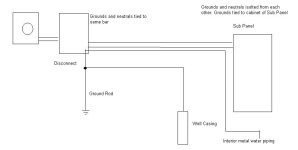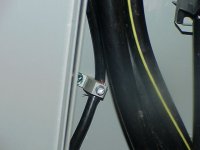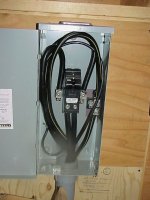You are using an out of date browser. It may not display this or other websites correctly.
You should upgrade or use an alternative browser.
You should upgrade or use an alternative browser.
Trouble with Compressor blowing Breaker
- Thread starter jedens
- Start date
/ Trouble with Compressor blowing Breaker
#31
Mark_in_NH
Veteran Member
- Joined
- Mar 4, 2002
- Messages
- 1,567
- Location
- Moultonborough, New Hampshire
- Tractor
- New Holland TC35D w/ 16LA FEL
</font><font color="blue" class="small">( the sub panel has the whites wires isolated and tied to the wire that goes to the ground rods. The neutral bar has the bare copper wires from the romex attached to it )</font>
Assuming that you have your teminology correct. The white wires in your romex are your neutral's (110 volt circuts) and should be all tied into your panels neutral bar. The bare copper wires in your romex are the grounds and should all be tied into your ground.
If you have any GFIC breakers in your panel then the neutral wire from your romex ties into the breaker and then the white neutral from the breaker ties into the neutral bar.
Assuming that you have your teminology correct. The white wires in your romex are your neutral's (110 volt circuts) and should be all tied into your panels neutral bar. The bare copper wires in your romex are the grounds and should all be tied into your ground.
If you have any GFIC breakers in your panel then the neutral wire from your romex ties into the breaker and then the white neutral from the breaker ties into the neutral bar.
Mark_in_NH
Veteran Member
- Joined
- Mar 4, 2002
- Messages
- 1,567
- Location
- Moultonborough, New Hampshire
- Tractor
- New Holland TC35D w/ 16LA FEL
Inspector507,
In your drawing, which didn't seem to be al that crude. I don't see a ground into or out of the meter base. Is this not required in your neck of the woods ?
In NH we are required to have two 8' ground rods that are wired into the meter base first, and then that ground must be carried (unbroken) into the house, through the main panel, picking up the cold water line and of course any sub panels.
In your drawing, which didn't seem to be al that crude. I don't see a ground into or out of the meter base. Is this not required in your neck of the woods ?
In NH we are required to have two 8' ground rods that are wired into the meter base first, and then that ground must be carried (unbroken) into the house, through the main panel, picking up the cold water line and of course any sub panels.
Junkman
Super Member
</font><font color="blue" class="small">( Assuming that you have your terminology correct. The white wires in your romex are your neutrals (110 volt circuits) and should be all tied into your panels neutral bar. The bare copper wires in your romex are the grounds and should all be tied into your ground.
If you have any GFIC breakers in your panel then the neutral wire from your romex ties into the breaker and then the white neutral from the breaker ties into the neutral bar. )</font>
The white wires are mounted to a bar that is isolated from the metal panel. this bar then has a wire that goes to the ground rods and the well casing. On the way to the ground rods, it picks up the metal cases of the disconnect switches. In this first picture you will see the unbroken #4 copper wire with its insulation stripped off on the grounding lug in the 200 amp disconnect. This wire goes to the panel in the cellar and has the white wires mounted on an isolated ground bar. This is the same wire that goes to the well casing. There is no metal water pipe in the cellar that is in the ground, so this end goes to a ground rod that is installed under the panel. The copper water pipes are also connected to this ground rod. One piece of wire from cellar ground rod to the well pipe....
If you have any GFIC breakers in your panel then the neutral wire from your romex ties into the breaker and then the white neutral from the breaker ties into the neutral bar. )</font>
The white wires are mounted to a bar that is isolated from the metal panel. this bar then has a wire that goes to the ground rods and the well casing. On the way to the ground rods, it picks up the metal cases of the disconnect switches. In this first picture you will see the unbroken #4 copper wire with its insulation stripped off on the grounding lug in the 200 amp disconnect. This wire goes to the panel in the cellar and has the white wires mounted on an isolated ground bar. This is the same wire that goes to the well casing. There is no metal water pipe in the cellar that is in the ground, so this end goes to a ground rod that is installed under the panel. The copper water pipes are also connected to this ground rod. One piece of wire from cellar ground rod to the well pipe....
Attachments
Junkman
Super Member
Picture two of the interior of the 200 amp disconnect that has the meter socket on the other side of the wall. Same disconnect as in picture 1..... As you will note that the wire on the extreme right hand side of the box is isolated from the metal case. The top side of this wire is from the meter socket and it goes all the way to the cellar breaker panel and has all of the bare copper wires attached to a buss bar and is attached to that buss bar. Please give me the correct terminology for this group of bare copper wires...... ground or neutral?? I believe that this is "ground"...
Attachments
Mark_in_NH
Veteran Member
- Joined
- Mar 4, 2002
- Messages
- 1,567
- Location
- Moultonborough, New Hampshire
- Tractor
- New Holland TC35D w/ 16LA FEL
Junkman,
In your picture of the disconnect. The wires to the center right, with the yellow stripe is your neutral. The ground appears to be located to the lower left rear, kind of hidden behind the other wires.
In your picture of the disconnect. The wires to the center right, with the yellow stripe is your neutral. The ground appears to be located to the lower left rear, kind of hidden behind the other wires.
Junkman
Super Member
The white wires in the panel are attached to the wire on the lower left.... the bare copper wires are attached to the black wire with the yellow stripe..... is this reversed and wrong??? /forums/images/graemlins/confused.gif
Inspector507
Super Member
Mark,
In my neck of the woods, only one ground rod is required unless the inspector determines that you have more than 25ohms resistance on that rod. Then one more is driven and they are tied together.
On residential, the local power company does not want a ground in the meter, but requires it on commercial installations.
In the installation you have described....... it creates a parallel path to ground which is strictly prohibited in the NEC®. The electrical system can be grounded at any of 3 convenient spots, the service drop, the meter, or the first means of disconnect, at which it must tie to the neutral. Any other connections will create a parallel path.
Now, there are exceptions, as anyone that is familiar with the NEC® knows. If you have metal underground water pipes, then that is your main grounding electrode and your ground rod is supplemental.
After the first means of disconnect, the grounds and neutrals must remain isolated from each other, to maintain a low impedence path back to "ground". That ground is not your ground rod, but the power company's neutral. The ground rod is basically for dissipation of excessive voltage....i.e. lightning. Nothing more.
Now back to the water lines.......they need to be BONDED to the service neutral at the first means of disconnect if there is plastic coming in underground.
Sub panels should never be connected directly to the grounding electrode system, as they are grounded by the cable that feeds them. Of course that changes if we're talking about a second structure fed from the same source......another one of those exceptions.
In my neck of the woods, only one ground rod is required unless the inspector determines that you have more than 25ohms resistance on that rod. Then one more is driven and they are tied together.
On residential, the local power company does not want a ground in the meter, but requires it on commercial installations.
In the installation you have described....... it creates a parallel path to ground which is strictly prohibited in the NEC®. The electrical system can be grounded at any of 3 convenient spots, the service drop, the meter, or the first means of disconnect, at which it must tie to the neutral. Any other connections will create a parallel path.
Now, there are exceptions, as anyone that is familiar with the NEC® knows. If you have metal underground water pipes, then that is your main grounding electrode and your ground rod is supplemental.
After the first means of disconnect, the grounds and neutrals must remain isolated from each other, to maintain a low impedence path back to "ground". That ground is not your ground rod, but the power company's neutral. The ground rod is basically for dissipation of excessive voltage....i.e. lightning. Nothing more.
Now back to the water lines.......they need to be BONDED to the service neutral at the first means of disconnect if there is plastic coming in underground.
Sub panels should never be connected directly to the grounding electrode system, as they are grounded by the cable that feeds them. Of course that changes if we're talking about a second structure fed from the same source......another one of those exceptions.
Inspector507
Super Member
Junkman,
I've stared at your pics for quite some time. I would not approve that installation for power here in Ohio. It looks like the ground rod is the only connection to "ground". That is specifically prohibited by the NEC®.
There are 2 magic things about electricity. #1 if you touch one wire to another, magic smoke is released and there is no more electricity. #2 is electricity always wants to go back where it came from. If it has to travel 100' through the earth back to the transformer, something has to give. That usually is appliances and so forth. If it can travel back through the neutral conductor coming from the power company, it is happy.
I've stared at your pics for quite some time. I would not approve that installation for power here in Ohio. It looks like the ground rod is the only connection to "ground". That is specifically prohibited by the NEC®.
There are 2 magic things about electricity. #1 if you touch one wire to another, magic smoke is released and there is no more electricity. #2 is electricity always wants to go back where it came from. If it has to travel 100' through the earth back to the transformer, something has to give. That usually is appliances and so forth. If it can travel back through the neutral conductor coming from the power company, it is happy.
BIGUN
Gold Member
Mark in NH,
I would agree with you, the smaller black wire connected to the lug on the lower left side, attached to the can with the green screw (always a good sign of a ground lug /forums/images/graemlins/smirk.gif) is what I would consider the ground and should be connected to water pipes, ground rods, and bare copper wires on branch circuits.
The larger yellow stripe wire on the right looks like the neutral and the white insulated wires on branch circuits should attach to this.
I would agree with you, the smaller black wire connected to the lug on the lower left side, attached to the can with the green screw (always a good sign of a ground lug /forums/images/graemlins/smirk.gif) is what I would consider the ground and should be connected to water pipes, ground rods, and bare copper wires on branch circuits.
The larger yellow stripe wire on the right looks like the neutral and the white insulated wires on branch circuits should attach to this.


